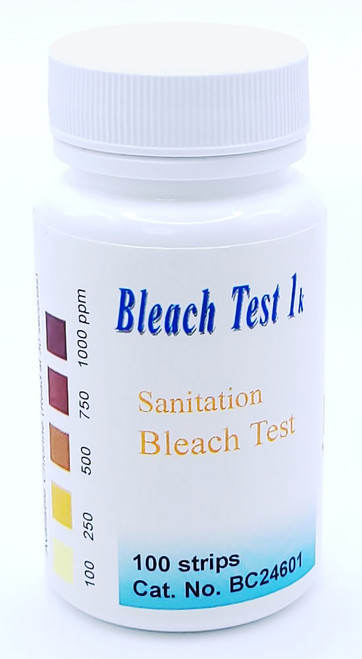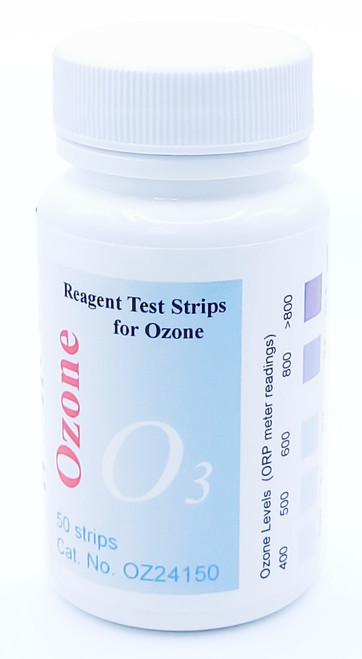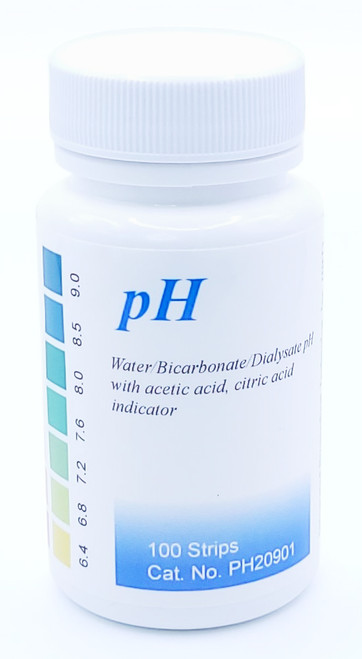Bleach Test 1K
Reagent test strips for chlorine in aqueous solution 100 - 1000 ppm
Summary:
- Dip-and-read strip
- Very easy to use
- Easy to read color blocks
- Color range: 100, 250, 500, 750, 1000 ppm chlorine
- Takes only 15 seconds
- 100 strips/bottle
Detail:
Chlorine Disinfection
Chlorine is a disinfectant widely used at home or in public facilities such as hospitals, clinics, food industries and day care centers. It is an indispensable chemical agent in maintaining public health. The ability of chlorine to destroy microorganisms is by its oxidative property and is highly dependent on its concentration. At a high concentration, it will kill bacterial instantly on contact. However, at a lower concentration, however, it will incapacitate the bacteria and prevent the spread of infection. A lower chlorine solution is used mainly for cleaning of work surfaces. The minimal effective chlorine concentration for use as a sanitizing solution is 500 ppm as recommended by the Center for Disease Control.
About the Test
The Bleach Test strip is a chemical indicator test strip designed to measure chlorine concentration in the range of 500 to 800 ppm, When the chlorine concentration is above or below that range, the strip will turn different color hue of brown and, that will allow the user to adjust the chlorine level by adding either more water or bleach to the solution. The chemicals in the strip will also react to other strong oxidative cleaning agent: however, the strip color can not be interpreted as chlorine levels indicated on the label.
Dilution of Bleach Solution
Bleach products purchased from retail stores normally contain available chlorine in the range between 5 % to about 6 %, or 50,000 to 60,000 ppm. A 1 % dilution will result in a chlorine concentration between 500 to 600 ppm. Free chlorine in the solution is very unstable and can quickly evaporate into air and lose its potency. In order to assure a minimum effective concentration of 500 ppm for the whole use life of the solution, the chlorine concentration of the bleach solution when initially prepared should be higher than 500 ppm, but not high enough to pose safety risk of burning the skin on contact. In child care centers where children can easily come in contact with the bleach solution, the chlorine level in the bleach solution should not exceed 800 ppm. It is important that the chlorine concentration in the sanitizing bleach solution be tested to assure that the chlorine concentration is within the range of 500 to 800 ppm.
When preparing the bleach solution, it is highly recommend that distilled water be used for dilution. Tap water or drinking water may contain organic matters which will react with chlorine and cause the chlorine potency to drop. This, however, may not be critical because the organic matter content in a clean drinking water is usually very low. Taking into account the variations in chlorine strength in different bleach products, a 1.4 % dilution of the bleach solution will bring the chlorine level to within the range of 500 - 800 ppm.
The following table provide dilution ratio of bleach for various size of containers:
|
Water Containers
|
Bleach
|
% Dilution
|
Expected Chlorine Levels
|
|
1 Gallon = 128 oz = 3785 mL
|
50 mL
|
1.43 %
|
715 -786 ppm
|
|
1 Quart = 32 oz = 946 mL
|
12 mL
|
1.26 %
|
630-693 ppm
|
|
1 Pint = 16 oz = 473 mL
|
6 mL
|
1.26 %
|
630-693 ppm
|
|
Spray Bottles
|
Bleach
|
% Dilution
|
Expected Chlorine Levels
|
|
24 oz = 709 mL
|
9 mL
|
1.26 %
|
630-693 ppm
|
|
16 oz = 473 mL
|
6 mL
|
1.26 %
|
630-693 ppm
|
Gallon, quart, pint and oz are all US liquid measurements.
If a cup is used, the actual size of the cup may differ depending on the measuring system.
One fluid cup equals 8 ounces (liq.) or 236 mL.
One metric up equals 200 mL.
One tea cup equals 142 mL
Follow the 4 easy steps to prepare one gallon of bleach solution:
- Remove 50 mL of water from the full gallon jar of water.
- Fill the 50 mL cup with bleach.
- Pour the bleach into the gallon jar and mix.
- Dispense the amount of chlorine solution as needed and keep the jar capped tight at all times.
For preparation of chlorine solution directly into the spay bottle,
- Remove the spray head from the bottle.
- Fill with water to the shoulder of the bottle.
- Transfer the required amount of bleach into the bottle using a graduated plastic pipet.
- Replace the spray head and mix the solution thoroughly.
- Verify the chlorine concentration with the Bleach Test strip by spraying very briefly the solution onto the reagent pad and comparing the strip color with the color chart on the bottle.
It is important that the chlorine concentration of the diluted solution be verified with a test strip to assure that the chlorine level is within the range between 500 and 800 ppm. When transferring the chlorine solution, do not mix with an acid such as vinegar. Do not measure bleach with a metal container.
Storage
Store the strip at room temperature between 59-86F(15 - 30C). Do not refrigerate. Do not remove the strip with a wet hand and always immediately replace and tighten the cap.





